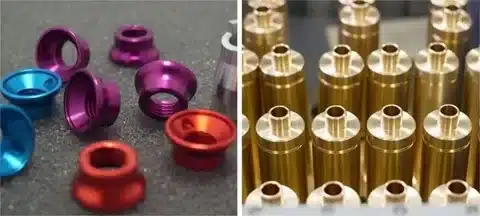Metals and different materials have been indispensible in human development for many years, and have been a significant part of everything from primordial tools, to modern technological advancements, with numerous examples . These comparison of copper and bronze materials are valued in their wide range of possibilities such as strength, durability, conductivity, malleability, and overall quality. Whether on the construction of infrastructure or manufacture of machinery to even the development of high-tech equipment, In addition to being essential components, metals play a crucial role in tooling within the modern world, allowing manufacturers to produce various complex parts .
What Are Metal Materials?

Metal materials are solid things that mostly come from metallic elements, or from their alloys, and are key in the production of various device . Usually, these materials have a crystalline structure, are good electricity/heat conductors possessing different levels of hardness/ flexibility/ corrosion resistance, essential for the production process . According to this classification there are ferrous (those which contain iron) and non-ferrous (those which don’t contain iron) metals and each of them has the advantages of their own depending on their properties.
Types of Metal Materials

There is division of metals according to their chemical composition and mechanical properties, with many being cost effective for various application . The most widely used metals in industry include ferrous metals, non-ferrous metals and specialty alloys.
1. Ferrous Metals
Iron is the principal component of ferrous metals. These kind of metals are normally strong and resistant but are very likely to corrode if electrolysis and oxidation occur when the wrong material is used or improperly produced in certain machines . when moisture and air have caused such exposure unless they are treated or alloyed with corrosion resistant materials, including specific resins .
2. Non-Ferrous Metals
Non-ferrous metals have no iron and with it – more resistant to corrosion. These metals and molded parts are commonly lighter, stronger in pliable and highly conductive, which makes them suitable for particular uses where two or more materials are combined, especially in injection molding, due to their lightweight nature .
3. Alloys
Alloys are often considered a type of composite, being metal and nonmetal or various metals mixtures for improved properties, with examples including brass and bronze . such as strength, ductility and corrosion resistance that are essential in best practices for material selection .
Properties of Metal Materials

Diverse qualities attribute metals to various areas of utility, making them a reliable production partner in many industries . These properties are commonly adapted to the requirements of specific industries.
1. Strength and Durability
Metals are famous for the fact that they can tolerate a lot of stress, but they will not break. Steel, in particular, is valued for its incredible tensile strength, and in case of which it is popular construction, automotive and machinery parts, allowing engineers to optimize design and functionality . The long lasting nature of metals also affects the cost, making them an affordable choice for their use in applications where prolonged performance is required under extreme conditions due to high demand .
2. Malleability and Ductility
Malleability is a metal’s capacity to be hammered or squeezed into thin sheets and ductility the property of elongating a metal into wire without fracture. Both properties are of critical importance in the manufacturing processes of rolling, forging, and drawing process, which also affect the final surface finish of the product .
3. Thermal and Electrical Conductivity
Most metal are very good conductors of heat and electricity, which has also made them suitable for applications in 3d printing . This characteristic is especially important for application such as electrical wiring (copper), injection molded part (such as plastic parts), and heat exchangers (aluminum)., and heat exchangers (aluminum). The capacity of metals to facilitate heat transfer effectively also makes them useful in cookery and in devices and systems with temperature regulation systems, in addition to their role in injection molding .
4. Corrosion Resistance
Various metals such as stainless steel, titanium, and aluminum, are naturally resistant to corrosion; hence they are excellent materials for areas that require the presence of moisture, chemicals or high temperatures.
Applications of Metal Materials

The applicability’s of metals are important in various industries. Below are some common applications:
1. Construction
Metals, and especially steel, are necessary constructions in the building – bridges, infrastructure etc., making them ideal production parts in various projects The strength and averment of steel make steel the standout construction material for structural frameworks, beams, and strong reinforcements.
2. Automotive
Metals have a high use within the automotive industry with steel and aluminum being used in the construction of frames and engines and other parts of vehicles. For optimization of fuel consumption, aluminum is used which is lighter than steel, that is used for strength and safety, despite the higher cost associated with aluminum .
3. Aerospace
In aerospace, aluminum, titanium and specialized alloys are used in manufacturing airplane and space crafts. These metals are valued as a material because they are lightweight but are strong enough, to an extent undettable, to withstand the extreme temperature and pressure.
4. Electronics
Copper and aluminium are widely used for the electronics industry owing to their good electrical conductivity. These metals are applied in wiring, and circuit boards and heat sinks to guarantee optimal production and operation of electronic gadgets.
5. Medical
Titanium and stainless steel have been used in medical devices and implants; owing to their strength, biocompatibility, and corrosion resistance, they are also valuable in prototyping for new medical technologies. Such materials, including carbon fiber, are applied in surgical instruments, joint replacements and dental implants.
Conclusion
Metal materials are a cornerstone for almost every industry; they offer critical properties like strength, durability, conductivity, tolerance to wear and corrosion. Be it ferrous metals such as steel and cast iron, or non-ferrous metal such as aluminium and copper or alloys such as brass and stainless steel, each of these metals come with a set of unique merits to their advantage in different uses.


